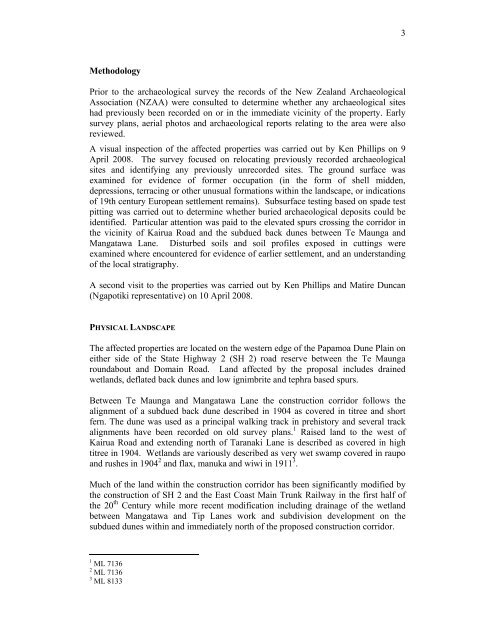2. Mangatawa catchment consents for earthworks, storm water ...
2. Mangatawa catchment consents for earthworks, storm water ...
2. Mangatawa catchment consents for earthworks, storm water ...
- No tags were found...
Create successful ePaper yourself
Turn your PDF publications into a flip-book with our unique Google optimized e-Paper software.
3<br />
Methodology<br />
Prior to the archaeological survey the records of the New Zealand Archaeological<br />
Association (NZAA) were consulted to determine whether any archaeological sites<br />
had previously been recorded on or in the immediate vicinity of the property. Early<br />
survey plans, aerial photos and archaeological reports relating to the area were also<br />
reviewed.<br />
A visual inspection of the affected properties was carried out by Ken Phillips on 9<br />
April 2008. The survey focused on relocating previously recorded archaeological<br />
sites and identifying any previously unrecorded sites. The ground surface was<br />
examined <strong>for</strong> evidence of <strong>for</strong>mer occupation (in the <strong>for</strong>m of shell midden,<br />
depressions, terracing or other unusual <strong>for</strong>mations within the landscape, or indications<br />
of 19th century European settlement remains). Subsurface testing based on spade test<br />
pitting was carried out to determine whether buried archaeological deposits could be<br />
identified. Particular attention was paid to the elevated spurs crossing the corridor in<br />
the vicinity of Kairua Road and the subdued back dunes between Te Maunga and<br />
<strong>Mangatawa</strong> Lane. Disturbed soils and soil profiles exposed in cuttings were<br />
examined where encountered <strong>for</strong> evidence of earlier settlement, and an understanding<br />
of the local stratigraphy.<br />
A second visit to the properties was carried out by Ken Phillips and Matire Duncan<br />
(Ngapotiki representative) on 10 April 2008.<br />
PHYSICAL LANDSCAPE<br />
The affected properties are located on the western edge of the Papamoa Dune Plain on<br />
either side of the State Highway 2 (SH 2) road reserve between the Te Maunga<br />
roundabout and Domain Road. Land affected by the proposal includes drained<br />
wetlands, deflated back dunes and low ignimbrite and tephra based spurs.<br />
Between Te Maunga and <strong>Mangatawa</strong> Lane the construction corridor follows the<br />
alignment of a subdued back dune described in 1904 as covered in titree and short<br />
fern. The dune was used as a principal walking track in prehistory and several track<br />
alignments have been recorded on old survey plans. 1 Raised land to the west of<br />
Kairua Road and extending north of Taranaki Lane is described as covered in high<br />
titree in 1904. Wetlands are variously described as very wet swamp covered in raupo<br />
and rushes in 1904 2 and flax, manuka and wiwi in 1911 3 .<br />
Much of the land within the construction corridor has been significantly modified by<br />
the construction of SH 2 and the East Coast Main Trunk Railway in the first half of<br />
the 20 th Century while more recent modification including drainage of the wetland<br />
between <strong>Mangatawa</strong> and Tip Lanes work and subdivision development on the<br />
subdued dunes within and immediately north of the proposed construction corridor.<br />
1 ML 7136<br />
2 ML 7136<br />
3 ML 8133
















